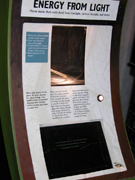


|
Life
Sciences
|
Energy from Light
|
When
light shines on grass, the grass absorbs the light's energy. This
sparks a series of chemical reactions that combine carbon dioxide
and water to make food. In this exhibit, when the light in the container
is shut off, the carbon dioxide level—as indicated on the screen—rises,
because the grass no longer has the energy to absorb it. When the
light shines again, the carbon dioxide level drops because it now
has the energy to absorb carbon dioxide. Grass and other green plants
trap the energy with a pigment called chlorophyll. This pigment
allows plants to use that energy to make food from carbon dioxide
and water. During this process, called photosynthesis, they also
produce oxygen as waste.
|

|







|